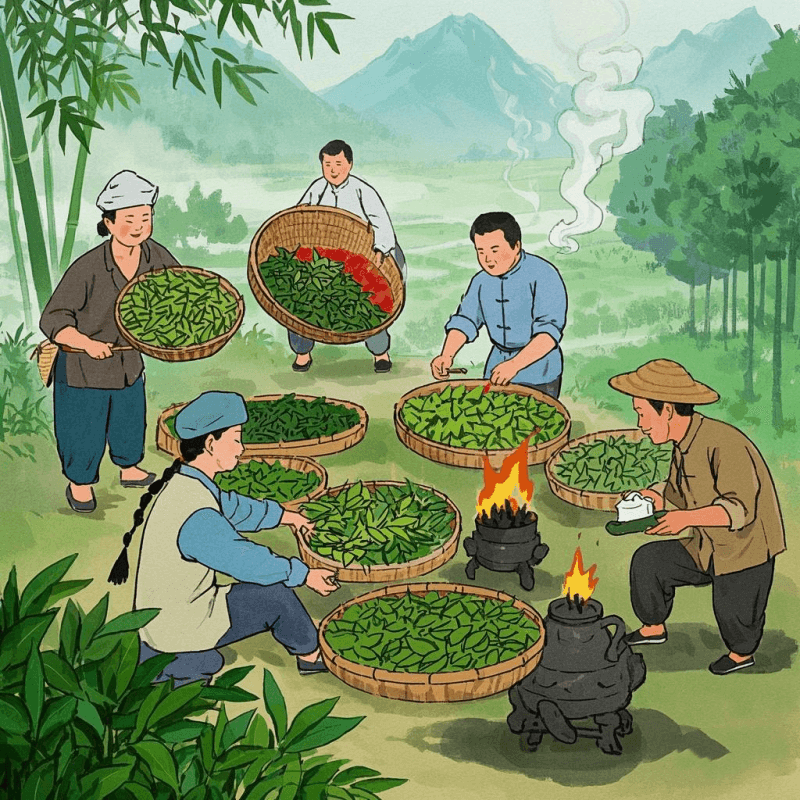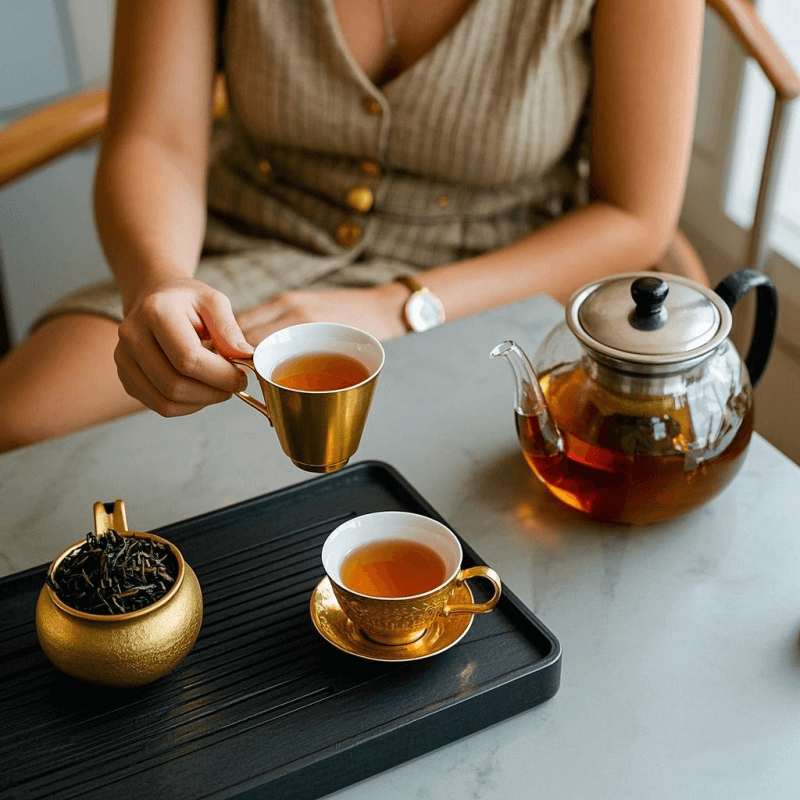What Is Oolong Tea?

Where it sits between green and black (oxidation & roast explained simply)
Oolong tea occupies the fascinating middle ground between green and black tea, with oxidation levels ranging from 20% to 80%. Think of oxidation as controlled browning—like an apple turning brown, but stopped at just the right moment. Green tea is barely oxidized (5-10%), black tea is fully oxidized (85-95%), while oolong captures that sweet spot in between. Many oolongs also undergo roasting, adding toasty, caramel notes that distinguish them from their unroasted cousins.
Regions & styles at a glance (Fujian, Guangdong, Taiwan; Tieguanyin, Wuyi, Dancong, high-mountain)
Fujian Province gives us the famous Tieguanyin (Iron Goddess) with its floral elegance and Wuyi rock oolongs with their mineral complexity. Guangdong’s Dancong oolongs burst with fruity aromatics, while Taiwan’s high-mountain oolongs offer creamy sweetness with incredible depth. Each region’s climate, soil, and processing traditions create distinct flavor profiles that even beginners can learn to recognize.
How it’s made: wither → bruise → oxidize → fix → roll → roast
The magic happens in six steps: leaves are withered under sun or shade to reduce moisture, then gently bruised (often by shaking in baskets) to break cell walls and start oxidation. The oxidation process is carefully monitored—sometimes for hours—before being “fixed” with heat to stop it. Rolling shapes the leaves and releases oils, followed by optional roasting that can range from light toasting to deep, transformative heat.
First Sips: My Honest Impressions
The moment the aroma “blooms” (orchid, honey, stonefruit, or toasted nuts)
My first quality oolong was a revelation. As hot water hit the leaves, an incredible bouquet erupted from my gaiwan—orchid petals mixed with honey and a hint of ripe peach. This “bloom” moment never gets old; it’s like opening a gift every time you brew. Different oolongs offer different aromatherapy experiences: some smell like fresh flowers, others like warm toast or tropical fruit.
Aftertaste (hui gan), throat sweetness, and how the second infusion surprised me
What caught me off guard was the aftertaste—what the Chinese call “hui gan” or returning sweetness. Minutes after my first sip, a pleasant sweetness would resurface in my mouth, completely natural and addictive. The second infusion often surpasses the first, revealing hidden layers of flavor as the tightly rolled leaves fully unfurl.
Taste Map of Oolong (Find Your Style)
Green-leaning oolongs (floral, buttery)
Lightly oxidized oolongs (20-40%) like Tieguanyin or Taiwanese high-mountain varieties offer delicate, floral notes with buttery smoothness. These are perfect for afternoon sipping and pair beautifully with light foods. They’re forgiving for beginners and showcase oolong’s elegant side.
Mid-oxidized (fruity, creamy, balanced)
The 40-60% oxidation range produces some of oolong’s most approachable teas. Think tropical fruit, stone fruits, and creamy textures. Taiwan’s Dong Ding and some traditional Tieguanyin styles shine here, offering complexity without overwhelming intensity.
Dark/roasted (mineral, cocoa, wood, spice)
Heavily oxidized and roasted oolongs (60-80%+) like Wuyi Yancha deliver bold, masculine flavors—dark chocolate, roasted nuts, mineral notes, and warm spices. These are perfect for cold mornings or pairing with hearty foods. They can handle aggressive brewing and actually improve with higher temperatures.
How to Brew Oolong Tea (Zero-Stress + Gongfu Options)
Western mug method (simple, reliable)
For daily brewing, use 1 teaspoon of leaves per 8 oz of 190-200°F water. Steep 3-4 minutes for light oolongs, 4-5 minutes for darker ones. This method is foolproof and perfect for busy mornings. Don’t be afraid to re-steep the same leaves 2-3 times—they’ll reward you with different flavor notes each round.
Gongfu session (gaiwan or small teapot): leaf ratios, water temp, short steeps

For the full oolong experience, try gongfu brewing: use 1/3 of your vessel’s volume in leaves with 190-212°F water. Start with 30-second steeps, gradually increasing time. This method reveals oolong’s evolution through multiple infusions—some leaves easily give 8-10 delicious cups.
Water matters: temperature ranges and when to go hotter/cooler
Light oolongs prefer 190-200°F to preserve delicate florals, while dark, roasted oolongs thrive at 200-212°F to extract their deep flavors. When in doubt, start cooler and adjust upward if the tea tastes flat or underdeveloped.
Troubleshooting bitterness or flat flavor
Bitterness usually means water too hot, steeping too long, or too many leaves. Flat flavor suggests the opposite—cooler water, shorter steeps, or fewer leaves. Oolong is forgiving; adjust and try again.
Benefits & Caffeine (Realistic, No Hype)
L-theanine focus, gentle lift from caffeine—how it feels in the afternoon
Oolong provides 30-50mg of caffeine per cup (less than coffee’s 95mg), paired with L-theanine for smooth, sustained energy without jitters. I notice improved focus around 2 PM without the crash that follows coffee. The combination feels clean and sustaining—perfect for afternoon productivity.
What research suggests vs. what I actually notice in daily life
Studies suggest oolong may support metabolism and heart health, but I focus on what I actually experience: better hydration than coffee, improved afternoon energy, and a mindful brewing ritual that naturally slows me down. The real benefit might be the 10-minute tea break itself.
Who should be cautious (pregnancy, caffeine-sensitive, late-night drinkers)
Pregnant women should limit caffeine intake, and those sensitive to caffeine might want to avoid oolong after 2 PM. If you’re caffeine-sensitive, start with light oolongs and smaller portions to gauge your tolerance.
Buyer’s Guide: Choosing Quality Oolong
Leaf appearance, aroma, roast freshness, and cultivar cues
Quality oolong leaves should be whole, uniform in size, and aromatic when dry. Fresh roasted oolongs smell toasty without any staleness. Look for specific cultivar names (like Jin Xuan or Tie Guan Yin) rather than generic “oolong” labels—this indicates quality sourcing.
Milk oolong: natural Jin Xuan creaminess vs. flavored versions
True “milk oolong” comes from the naturally creamy Jin Xuan cultivar. Artificially flavored versions exist but lack the subtle complexity of the real thing. Natural milk oolong should taste creamy without any obvious vanilla or milk flavoring.
Price sanity check: when to splurge, when to skip
Good daily-drinking oolong runs $15-30 per 100g. Splurge ($40-80+) for special occasions or when you want to explore premium terroir. Skip anything under $10—it’s likely stale or poor quality. Sample sizes are smart for exploring new styles.
Storage tips to keep leaves lively
Store oolong in airtight containers away from light, heat, and strong odors. Roasted oolongs stay fresh longer than green-leaning ones. Don’t refrigerate—room temperature in a dark cupboard works best.
Oolong Tea vs. Green, Black, and White
Flavor, body, brewing forgiveness, and best use-cases
Oolong offers more complexity than green tea, more subtlety than black tea, and more body than white tea. It’s incredibly forgiving—hard to ruin completely—making it perfect for experimentation. Use light oolongs for afternoon relaxation, dark ones for morning energy, and mid-range styles for any time.
When to rotate based on season/mood
I reach for green-leaning oolongs in spring and summer, roasted varieties in fall and winter. Light oolongs suit contemplative moods, while dark oolongs match active, social occasions. The variety means you’ll never get bored.
My 30-Day Oolong Journal (What Changed)
Week-by-week notes: energy, focus, palate, and favorite styles
Week 1: Everything tasted “different”—my palate needed calibrating. Week 2: Started distinguishing floral from fruity notes. Week 3: Discovered my preference for medium-oxidized styles. Week 4: Developed a reliable afternoon routine and noticed sustained energy without coffee crashes.
What didn’t work (over-leafing, too cool water) and the fixes
Early mistakes included using too many leaves (bitter results) and water that was too cool (flat, underdeveloped flavor). The fixes were simple: less leaf, hotter water, shorter initial steeps. Oolong taught me that good tea rewards patience and attention.
FAQs About Oolong Tea
Q: How many cups can I get from the same leaves? A: Good oolong easily gives 4-6 Western-style cups or 8-12 gongfu infusions.
Q: Does roasted oolong have more caffeine? A: Roasting doesn’t significantly change caffeine levels—it’s mainly about oxidation and leaf grade.
Q: Can I cold-brew oolong? A: Absolutely! Use more leaves and steep overnight in the refrigerator for smooth, sweet results.
Q: Why is my oolong bitter? A: Usually too hot water, too long steeping, or too many leaves. Adjust and try again.
Q: Should I wash/rinse oolong leaves first? A: A quick 5-second rinse can “awaken” the leaves, but it’s not mandatory for quality oolong.
Q: How long do oolong leaves stay fresh? A: Properly stored, 2-3 years for most oolongs. Roasted varieties can improve with age.
Final Take: Who Will Love Oolong—and How to Start
Oolong appeals to curious tea drinkers who want more complexity than green tea but find black tea too bold. It’s perfect for people who enjoy the ritual of brewing and those seeking sustained energy without caffeine spikes.
Coffee drinkers often love dark, roasted oolongs, while green tea fans gravitate toward light, floral styles. If you’re analytical and enjoy comparing flavors, oolong’s diversity will fascinate you.
Start with a medium-oxidized Taiwan oolong or Tieguanyin—they’re approachable yet complex. Buy from reputable vendors offering small sample sizes, and don’t overthink the brewing. Oolong rewards experimentation and forgives mistakes, making it the perfect tea for both beginners and lifelong learners.
